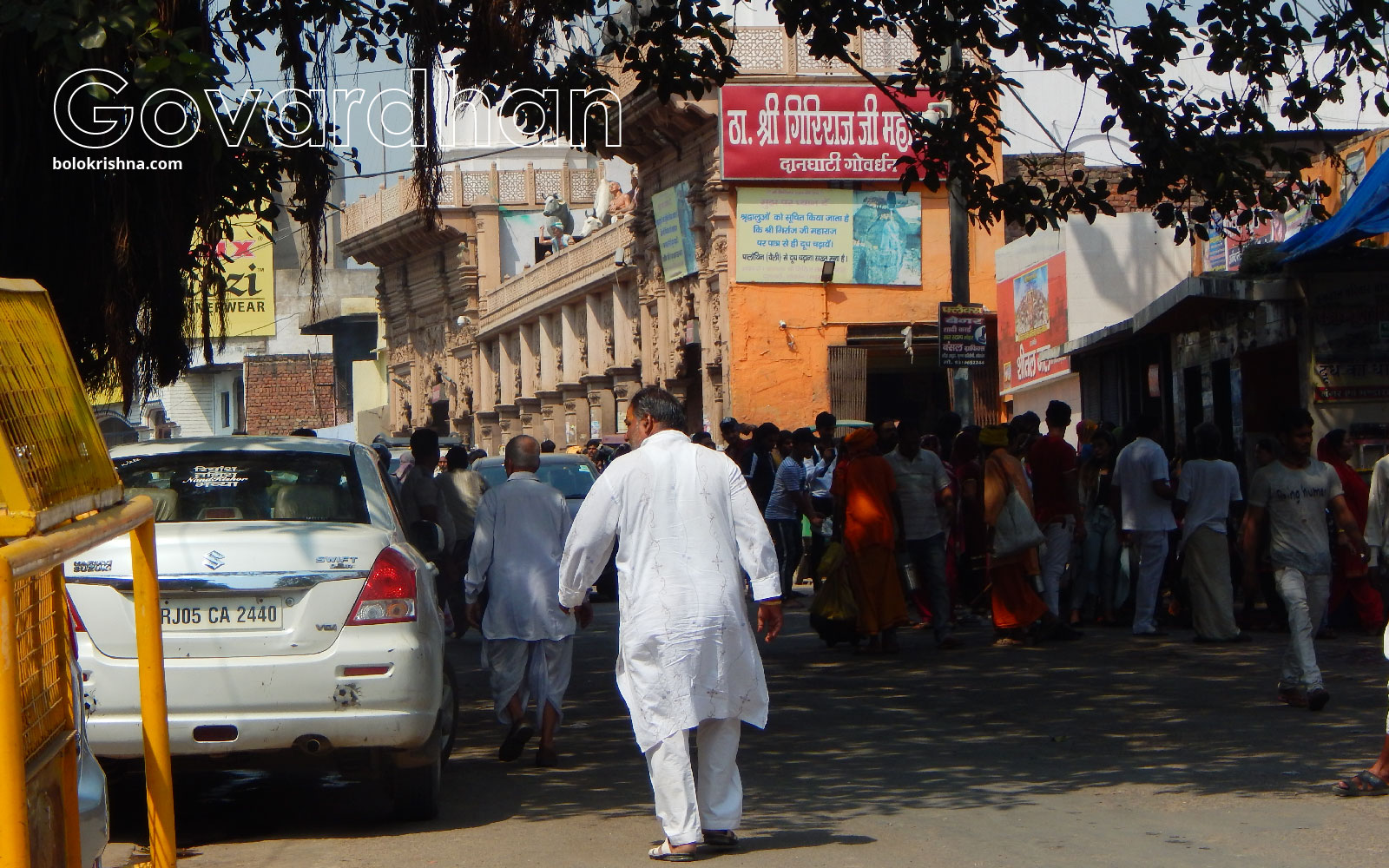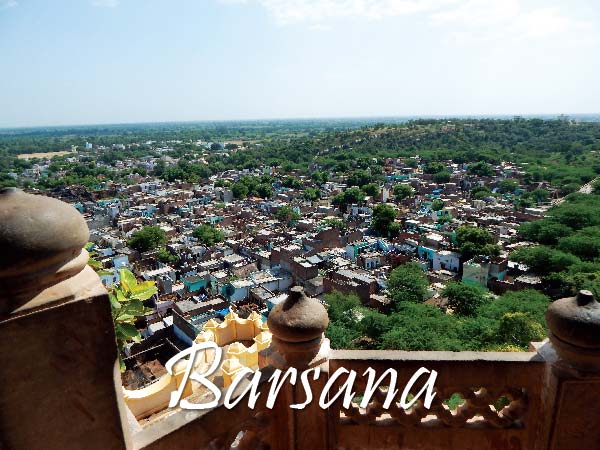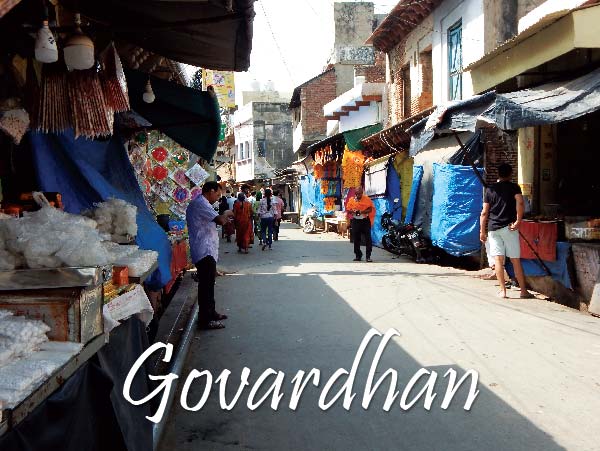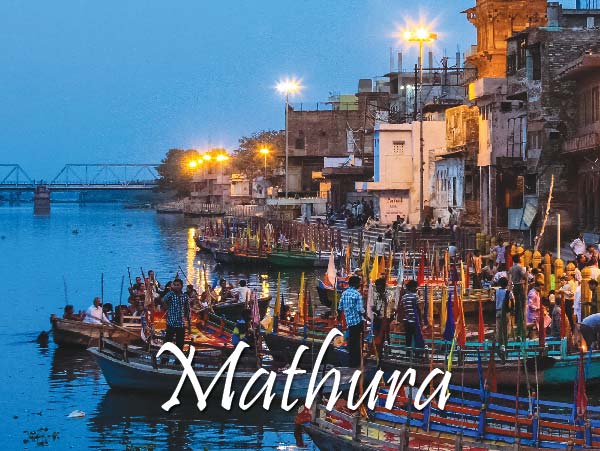Govardhan, the place where Shri Krishna performed the most famous leela.

Govardhan Govardhan's identity as a haven of spiritual nourishment
Introduction
Nestled amidst the enchanting landscapes of Braj, a region steeped in mythology and spiritual significance, lies Govardhan, a place that resonates with divine tales and timeless devotion.
Amidst the echoes of ancient chants and the fragrance of incense, Govardhan stands as a living testament to India’s rich heritage and spiritual heritage. As we delve into the depths of this sacred land, we uncover the layers of significance that have drawn seekers, devotees, and travelers for centuries.
Govardhan’s roots trace back to the annals of history, adorned with stories that transcend time. The pages of mythology reveal its connection to Lord Krishna, the embodiment of divinity and love. It is in the land of Govardhan that Krishna displayed his miraculous prowess, lifting the entire Govardhan Hill on his little finger to protect the villagers from the wrath of Lord Indra’s thunderstorm. This profound act symbolizes protection, compassion, and the power of devotion over cosmic forces.
The spiritual act of parikrama, or circumambulation, around the Govardhan Hill is a practice that unites pilgrims and devotees from all walks of life. The circular journey around this sacred hill is not just a physical endeavor but a metaphoric one, signifying the cyclical nature of life and the unending devotion to the divine. Pilgrims, young and old, embark on this journey with hearts full of devotion, seeking blessings, spiritual growth, and a connection with the divine.
Festivals in Govardhan are vibrant expressions of devotion and gratitude. The Govardhan Puja, also known as Annakut, is a visual feast of devotion, where an assortment of delicacies is offered to the divine, signifying abundance and humility. The atmosphere is charged with devotion, as the festival reinforces the understanding that the divine nurtures and sustains all life.
The devotion that invokes is not confined to rituals but extends to the realm of the heart. Bhakti, the profound love and devotion to the divine, finds its embodiment in the tales of saints, ascetics, and seekers who have made Govardhan their spiritual haven. The soil of this land has absorbed the tears of longing and the prayers of countless devotees.
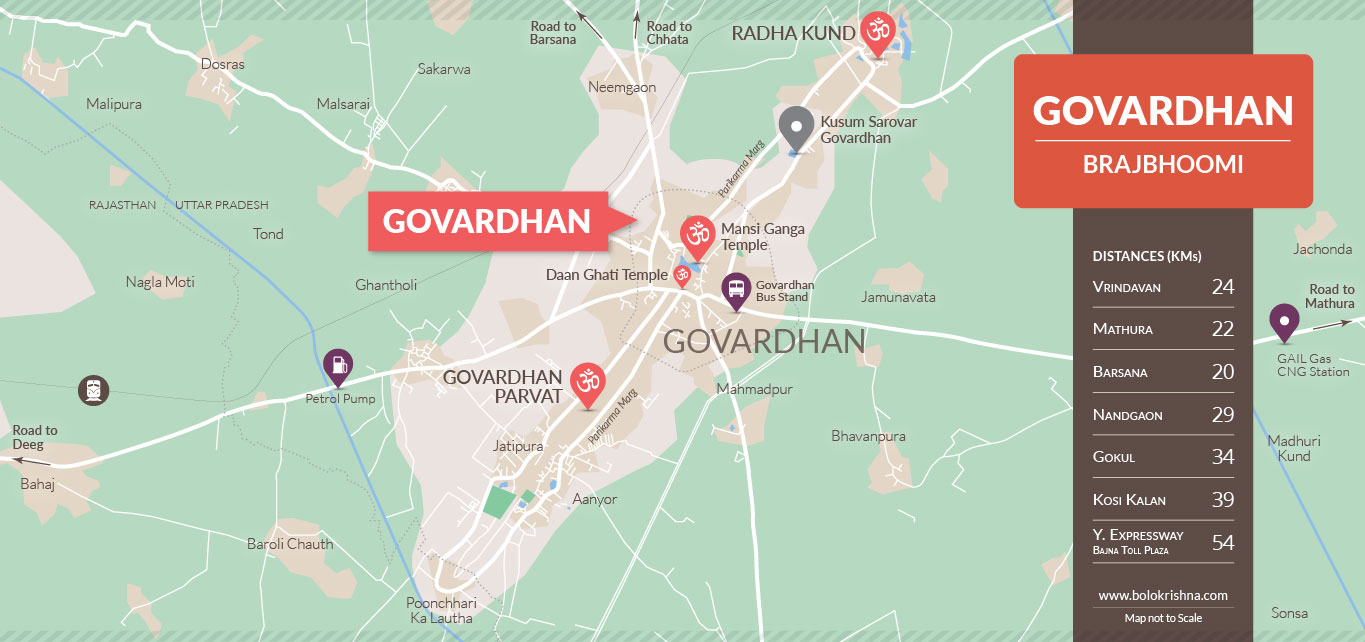
Unearthing the Ancient Roots
The historical significance of Govardhan reverberates through the annals of time, weaving a tapestry that intertwines spirituality, culture, and tradition. Nestled in the heart of the Braj region, Govardhan has been a witness to countless stories and events that have shaped its identity as a sacred land.
Ancient Roots and Legends:
The roots of Govardhan’s historical importance stretch back to ancient times. The town finds mention in the Puranas, the ancient Hindu scriptures, where it is revered as a sacred site associated with Lord Krishna’s divine exploits. The Puranas narrate the tale of Lord Krishna lifting the Govardhan Hill to provide shelter to the villagers from the torrential rains caused by Lord Indra’s fury. This legendary event, known as the Govardhan Lila, not only showcases Krishna’s divine power but also emphasizes the significance of protecting and nurturing all living beings.
Association with Lord Krishna:
The Govardhan Lila remains a cornerstone of Govardhan’s historical significance. Lord Krishna’s connection with the town runs deep, as it is believed to be the backdrop of many episodes from his life. The town’s geographical features, including the Govardhan Hill itself, serve as reminders of Krishna’s divine presence and his interactions with the locals.
Cultural and Spiritual Heritage:
Over the centuries, historical significance has been preserved and enriched by generations of devotees, poets, and saints. The town’s spiritual aura has attracted scholars, philosophers, and artists, leading to the creation of a rich cultural heritage that resonates with the teachings of Lord Krishna. It has served as an inspiration for numerous literary works, paintings, sculptures, and devotional songs that celebrate the divine grace and teachings associated with Govardhan.
Pilgrimage Destination:
Govardhan’s historical legacy is intrinsically linked to its status as a pilgrimage destination. Pilgrims and seekers have journeyed for centuries, seeking spiritual solace and a deeper connection to the divine. The practice of parikrama, the circumambulation of the Govardhan Hill, has been a revered tradition for pilgrims, symbolizing devotion, humility, and the cyclical nature of life. This ancient practice has been a means for devotees to partake in the historical and spiritual essence of Govardhan.
Preservation Efforts:
Recognizing the historical importance of Govardhan, efforts have been made to preserve its cultural and spiritual heritage. Temples, ashrams, and other sacred sites have been maintained and renovated to ensure that the historical and architectural significance remains intact. Preservation initiatives also extend to the natural environment, such as the Govardhan Eco Village project, which aims to promote sustainable practices and environmental conservation while honoring the town’s historical heritage.
The Divine Dance of Govardhan Lila
Among the myriad tales that intertwine with Govardhan’s legacy, none shines brighter than the enchanting episode of Govardhan Lila, a divine dance that encapsulates the essence of Lord Krishna’s boundless love, compassion, and power. This timeless narrative not only reflects Krishna’s divine nature but also imparts profound spiritual lessons that continue to resonate with devotees through the ages.
Setting the Stage:
The Govardhan Lila unfolds in the sacred setting of Govardhan Hill, an embodiment of nature’s beauty and divine energy. The tale begins with the villagers of Gokul preparing to perform a grand sacrifice in honor of Lord Indra, the god of rain. However, young Krishna, with his wisdom beyond his years, questions the necessity of such offerings and rituals. He advocates a shift in focus from worshiping external deities to recognizing the divine presence within and all around.
Krishna’s Graceful Gesture:
As the villagers remain steadfast in their preparations for the Indra puja, Krishna decides to reveal his divinity through a display of cosmic prowess. Lifting the Govardhan Hill with a mere touch of his finger, Krishna transforms the hill into a colossal umbrella, providing shelter to the villagers, their livestock, and all of creation from the deluge unleashed by Lord Indra’s fury.
Unveiling Spiritual Wisdom:
The Govardhan Lila isn’t merely an exhibition of Krishna’s divine power; it’s a profound lesson in spirituality. Through this act, Krishna emphasizes the importance of humility, devotion, and the acknowledgment that all life is interconnected. The story underscores the idea that sincere devotion and a pure heart are more valuable than grand offerings and rituals.
Protection and Nurturing:
Krishna’s act of lifting the Govardhan Hill symbolizes his role as a protector and nurturer of all beings. It underscores the universal truth that the divine is present in every aspect of creation. Krishna’s compassion shines as he protects not only the villagers but also the animals, trees, and the land itself, embodying the message that God’s love encompasses all life forms.
Lessons for Life:
The Govardhan Lila imparts timeless lessons that extend beyond the confines of mythology. It teaches us the importance of selflessness, humility, and the power of true devotion. It encourages us to cultivate a deeper connection with the divine by recognizing and embracing the unity of all life. The episode also underscores the significance of environmental consciousness and the need to protect and care for the natural world.
Devotion in Practice:
Devotees from various walks of life are drawn to immerse themselves in the spiritual aura created by the Govardhan Lila. They undertake the parikrama, circumambulating the sacred hill, not merely as a physical act but as a symbolic journey of devotion and surrender. The Govardhan Lila serves as a reminder that through genuine devotion, one can transcend worldly limitations and experience the divine presence in all its glory.

Circumambulating the Divine Essence of Govardhan
In the heart of the mystical Braj region, a practice that encapsulates devotion, spirituality, and the rhythm of life itself takes center stage: the sacred parikrama of Govardhan Hill. This age-old tradition, more than just a physical journey, symbolizes a profound spiritual pilgrimage, a continuous circle of faith that echoes the cyclical nature of existence and the devotion to the divine.
The Essence of Parikrama:
The word “parikrama” itself implies circumambulation or encircling. When pilgrims embark on the Govardhan parikrama, they engage in a journey that encircles the sacred Govardhan Hill, often covering a distance of about 21 kilometers. However, the significance of parikrama transcends mere distance; it’s a metaphorical expression of the journey of life, with its twists, turns, and constant connection to the divine.
Pilgrimage with Purpose:
Undertaking the parikrama isn’t merely an act of physical exertion; it’s a spiritual endeavor laden with devotion and intention. Pilgrims engage in this practice to seek blessings, express gratitude, and strengthen their bond with the divine.
The Inner Parikrama:
While the outer parikrama involves walking around the physical Govardhan Hill, there’s also an inner parikrama that occurs within the devotee’s heart. As pilgrims walk the path, they introspect, meditate, and contemplate the spiritual journey they’re undertaking. The external circumambulation becomes a mirror of their inner journey, with each step bringing them closer to their own divine essence.
Stations of Devotion:
Along the parikrama path, devotees encounter various holy sites and landmarks, each with its own significance. From the Mansi Ganga, a sacred water body, to the Mukharavinda Temple, where Lord Krishna’s footprints are revered, each station becomes a focal point for prayer, reflection, and connection. The Govardhan Lila Rock, where Lord Krishna lifted the hill, stands as a powerful reminder of his divine grace.
Cultivating Humility:
The practice of parikrama also instills a sense of humility in pilgrims. The act of circumambulating a hill, regardless of its size, demonstrates the willingness to bow down to the divine and to recognize the vastness of the cosmic order. This humility is a cornerstone of devotion, acknowledging that one is part of a greater whole.
Transcending Time:
The practice of parikrama has remained unchanged for centuries, transcending the bounds of time. In a rapidly changing world, the parikrama offers a glimpse into the eternal, a connection to the spiritual heritage of the past that continues to guide and inspire in the present.
Culmination of Devotion:
As pilgrims complete the parikrama, a sense of accomplishment and spiritual fulfillment envelopes them. The journey of circumambulation, both external and internal, culminates in a profound connection to the divine. The experience of parikrama becomes a cherished memory, a testimony to the enduring power of faith and devotion.

Embodiments of Devotion in Govardhan
In this sacred land, where divinity and nature converge in harmonious resonance, temples and spiritual centers stand as timeless witnesses to the devotion that has flowed through the ages. These architectural marvels, adorned with intricate carvings and vibrant colors, serve as conduits for seekers to connect with the divine and immerse themselves in the spiritual atmosphere that pervades the town.
Govardhan Nath Ji Temple:
Among the most revered temples is the Govardhan Nath Ji Temple, dedicated to Lord Krishna. This temple is a center of spiritual energy, drawing devotees from all corners of the world. The main deity, Lord Krishna, is often depicted lifting the Govardhan Hill in a posture of grace and power, immortalizing the iconic Govardhan Lila. The temple’s intricate architecture and vibrant atmosphere create an ambiance that envelops visitors in a sense of awe and devotion.
Daan Ghati Temple:
Located near the Govardhan Hill, the Daan Ghati Temple holds a special place in the hearts of devotees. It is believed to be the site where Lord Krishna’s divine play unfolded as he accepted offerings of food from his childhood friend Sudama. The temple’s serene ambiance and the presence of the divine grace of Lord Krishna evoke a deep sense of devotion and humility in all who visit.
Mansi Ganga Lake and Temple:
The Mansi Ganga Lake, surrounded by temples and ghats, adds to the spiritual aura of Govardhan. Legend has it that the lake originated from the mind of Radha, Krishna’s beloved, making it a sacred reservoir of emotions and devotion. The Mansi Ganga Temple, dedicated to Radha and Krishna, is a place of reflection and meditation, offering a serene environment for seekers to connect with the divine essence.
Radha Kund and Shyam Kund:
Radha Kund and Shyam Kund are two holy water bodies that hold immense significance for devotees. It is believed that these were the ponds formed by Krishna himself for his beloved Radha and his own purification after the Govardhan Lila. Pilgrims come to these kunds (ponds) to cleanse themselves physically and spiritually, with the belief that a dip in these sacred waters can bring about profound spiritual transformation.
Other Temples and Ashrams:
Apart from these prominent temples, Govardhan hosts a plethora of smaller temples, ashrams, and spiritual centers, each with its unique flavor and significance. These include the Mukharavinda Temple, the Kusum Sarovar Temple, and the Priyakant Ju Temple, among others. Each temple contributes to the diverse spiritual landscape of Govardhan, offering a variety of devotional experiences for seekers.
Sacred Vibrations and Devotion:
Temples and spiritual centers aren’t mere structures; they are living entities that resonate with the vibrations of devotion and faith. Pilgrims and devotees come to these spaces to not only witness divine images but to experience a communion with the divine presence. Through rituals, prayers, and contemplation, these spaces become channels through which devotees can express their love and seek solace.
Reveling in Devotion at Govardhan
Govardhan’s sacred land resonates with the vibrant rhythms of festivals and celebrations that bring devotees together in a joyous communion with the divine. These events are not merely occasions for merriment; they are windows into the profound devotion and spiritual fervor that characterize Govardhan’s atmosphere. Let’s dive into the colorful tapestry of festivals that paint Govardhan with shades of devotion.
Govardhan Puja (Annakut):
One of the most anticipated festivals in Govardhan is Govardhan Puja, also known as Annakut, which falls on the day following Diwali. This festival is a visual feast for both the eyes and the soul. Devotees offer a dazzling array of food items and delicacies as an offering to the divine, signifying gratitude for the bounty of nature. The offerings are arranged in a mountain-like structure, symbolizing the Govardhan Hill itself. The festival celebrates the episode of Krishna lifting the Govardhan Hill, highlighting the significance of divine protection and sustenance.
Radha Kund Snan:
The Radha Kund Snan, also known as Radha Kund Bathing Festival, holds great importance for devotees. It takes place on the full moon night of the month of Kartik (October/November). Devotees gather at Radha Kund and Shyam Kund, the two sacred ponds associated with Radha and Krishna, to take a ceremonial bath. The event is believed to cleanse not just the body but also the soul, fostering a deep spiritual connection with the divine.
Gopashtami:
Gopashtami, celebrated on the eighth day of the Kartik month, pays homage to Lord Krishna’s role as a protector of cows and a cowherd. Devotees offer prayers and rituals to cows, who are regarded as sacred in Hindu culture. The festival reflects Krishna’s affinity for the simple and pure-hearted, underscoring the importance of caring for all living beings.
Janmashtami:
Janmashtami, the birth anniversary of Lord Krishna, is celebrated with fervor and enthusiasm in Govardhan. The town comes alive with decorations, processions, and cultural performances that portray the life of Krishna. Devotees fast, engage in prayer, and immerse themselves in Krishna’s divine presence, commemorating his earthly arrival with devotion and joy.
Rasa Lila Celebrations:
The Rasa Lila celebrations in Govardhan are a testament to the love and playfulness of Radha and Krishna. These celebrations, which take place during the Kartik month, involve devotees enacting the joyful dances of Radha and Krishna. The atmosphere is charged with divine energy, and devotees lose themselves in the enchanting world of the divine couple’s celestial dance.
Devotional Melodies and Chants:
Festivals in Govardhan are incomplete without devotional songs, music, and dance. Bhajans, kirtans, and melodious chants fill the air, creating an atmosphere of spiritual bliss. Devotees lose themselves in the rhythmic cadence of devotion, allowing their hearts to merge with the divine melodies.
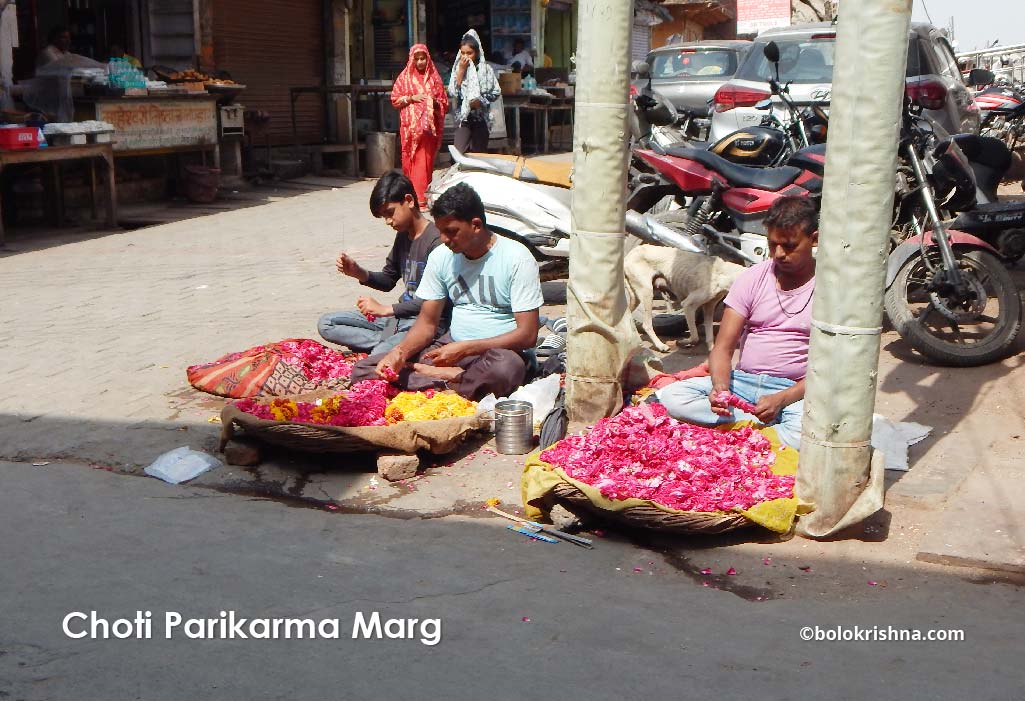
The Heartbeat of Govardhan’s Spiritual Realm
In the sacred embrace of Govardhan, the essence of bhakti (devotion) blooms in its purest form, woven into the very fabric of its existence. Bhakti is more than just a sentiment; it’s a way of life, a spiritual philosophy that reverberates through the hearts of devotees, sages, and seekers who are drawn to this hallowed land. Let’s delve into the depths of bhakti and explore how it finds its zenith in the spiritual haven of Govardhan.
The Essence of Bhakti:
Bhakti is a Sanskrit term that signifies an unwavering love, devotion, and surrender to the divine. It transcends religious boundaries, cultural differences, and intellectual debates, focusing on the intimate connection between the devotee and the divine. Bhakti embodies a selfless love that seeks nothing in return, an expression of the heart’s deepest yearning for union with the beloved.
Bhakti in Govardhan’s Stories:
Govardhan’s legacy is steeped in stories of bhakti that illuminate the path of seekers. From the gopis’ unwavering love for Krishna to Meera Bai’s soul-stirring devotion, Govardhan has been a canvas on which the tales of devotion have been painted in vibrant hues. These stories serve as beacons, guiding devotees on the journey of surrender and love.
The Bhakti Saints and Sages:
Throughout history, Govardhan has been a nurturing ground for saints, sages, and mystics who have epitomized the spirit of bhakti. Saint Haridas, whose dedication to chanting the holy names of God earned him Krishna’s grace, and the renowned poet-saint Surdas, whose compositions celebrate Krishna’s divine play, are just a few examples of the luminaries who have graced this land.
Ecstasy of Devotion:
In Govardhan, bhakti takes tangible form in the form of ecstatic devotion. Devotees engage in kirtans (devotional singing), bhajans (spiritual songs), and dance as they immerse themselves in the divine ecstasy. The joyous cries of “Radhe Radhe” and “Hare Krishna” reverberate through the air, creating an atmosphere charged with spiritual fervor.
Living in Devotion:
For the seekers who call Govardhan home, bhakti isn’t just a practice; it’s a way of life. The daily routines are imbued with devotion, from the early morning prayers to the humble acts of service. The simple acts of cooking, cleaning, and tending to the temple become offerings of love and devotion, a way to connect with the divine in every moment.
Bhakti as Transformation:
The essence of bhakti lies in its transformative power. Devotees who come to Govardhan often share stories of how their lives have been changed by their experiences. The depth of devotion and the spiritual environment have the potential to awaken the dormant seeds of love and longing, guiding individuals towards self-realization and union with the divine.
Nurturing the Soul at the Feet of Govardhan
Govardhan’s hallowed terrain beckons pilgrims and devotees from every corner of the world, transcending geographical boundaries to form a tapestry of devotion, unity, and spiritual aspiration. These seekers, driven by an innate longing for the divine, come to Govardhan to immerse themselves in its sacred aura and to experience a profound connection that rejuvenates their souls.
A Melting Pot of Devotees:
The pilgrimage to Govardhan brings together a diverse congregation of souls, each with their unique stories and motivations. From the wandering ascetic seeking solitude to the ardent devotee yearning for a deeper connection, Govardhan’s embrace is open to all who seek solace, transformation, and divine grace.
Seeking Spiritual Upliftment:
For many, the journey to Govardhan is a quest for spiritual elevation. The very act of embarking on this pilgrimage signifies a commitment to personal growth and self-realization. The sacred parikrama around the Govardhan Hill becomes a metaphor for the cyclical journey of life, reminding pilgrims of the impermanence of the material world and the eternal nature of the soul.
Experiencing Divine Presence:
Devotees come to Govardhan to experience a tangible connection with the divine. The presence of Krishna, Radha, and the sacred sites associated with them infuses the atmosphere with a sense of the sacred. As pilgrims walk the paths that Krishna himself trod, they feel a deep resonance with the past, sensing the divine energy that permeates the land.
Renewed Sense of Purpose:
The serene and spiritually charged environment of Govardhan offers a respite from the chaos of modern life. Pilgrims often speak of feeling rejuvenated, as if their burdens have been lifted. The experience allows them to gain a new perspective on life, rekindling a sense of purpose and clarity that they can carry back into their daily routines.
Unity Beyond Differences:
Govardhan’s aura of devotion creates an atmosphere of unity that transcends religious and cultural differences. Pilgrims from various faiths come together, united by a shared reverence for the divine and a common yearning for spiritual connection. This unity fosters a sense of global kinship that enriches the spiritual experience.
Inner Transformations:
The pilgrimage to Govardhan often brings about profound inner transformations. Devotees and pilgrims report experiencing moments of revelation, self-discovery, and spiritual awakening. The practices, rituals, and the sheer energy of the place work together to create an environment conducive to personal evolution.
Carrying the Grace Home:
The impact of Govardhan’s embrace doesn’t end with the pilgrimage itself. Pilgrims carry the grace and blessings they’ve received back into their lives, becoming beacons of positivity and devotion in their communities. The experience becomes a wellspring of strength and inspiration that helps them navigate life’s challenges.
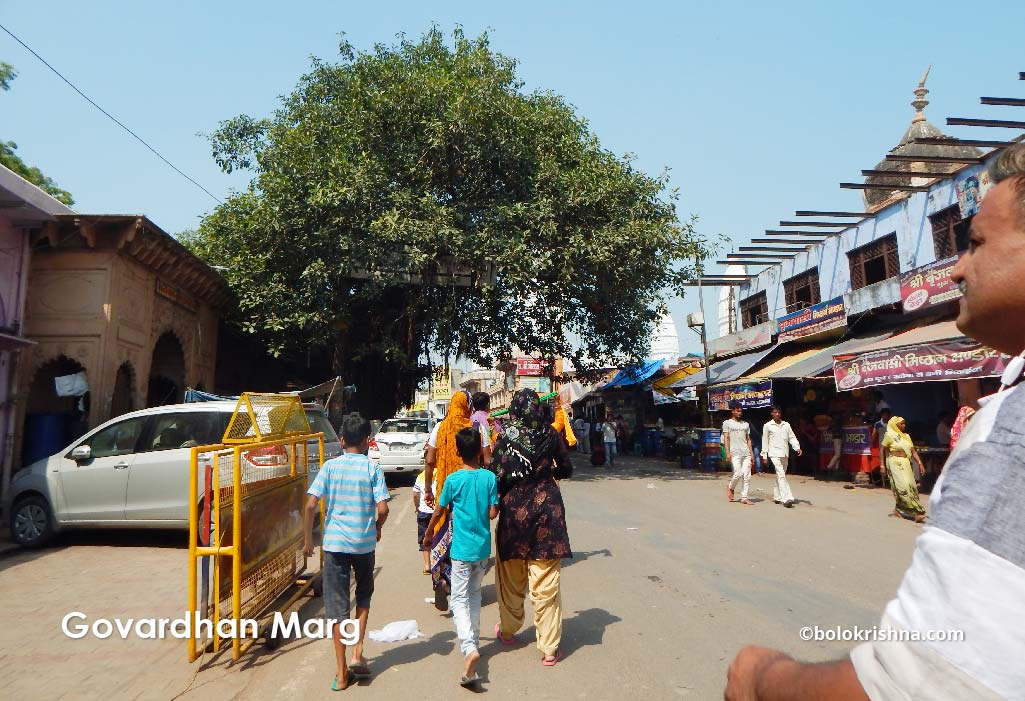
Journeying Within the Soul Amidst Govardhan’s Grace
As the sun rises over the enchanting landscapes of Govardhan, pilgrims and seekers embark on a journey that transcends the physical realm, reaching deep into the recesses of their souls. The pilgrimage to Govardhan isn’t just an external expedition; it’s a profound inner odyssey that invokes personal reflections, self-discovery, and a connection to the divine that defies description.
Silent Conversations with the Self:
In the quietude of Govardhan’s sacred spaces, pilgrims find the perfect canvas for introspection. The rhythmic footsteps of parikrama become a backdrop for silent conversations with the self. Amidst the vibrant bhajans and the chanting of sacred mantras, devotees listen to the whispers of their hearts, reflecting on their own journeys, desires, and aspirations.
Detachment from the Mundane:
The sacred atmosphere of Govardhan gently encourages a detachment from the material world. As pilgrims leave behind their daily routines, the town’s spiritual energy encourages them to shed the layers of mundane concerns, allowing them to enter a state of heightened awareness and mindfulness. This detachment paves the way for a deeper connection with the divine.
Mirroring Life’s Journey:
The parikrama around the Govardhan Hill mirrors the journey of life itself – full of twists, turns, challenges, and moments of grace. As pilgrims encounter uneven paths and steep ascents, they recognize the metaphor for life’s ups and downs. Each step becomes a reminder of the impermanence of material pursuits and the ultimate goal of spiritual evolution.
Unearthing Layers of Emotion:
Govardhan has a unique ability to unearth layers of emotion that often remain hidden in the hustle and bustle of daily life. Whether it’s the joy of being in the presence of the divine, the tears of surrender, or the profound stillness experienced during meditation, the pilgrimage becomes a mirror reflecting the kaleidoscope of human emotions.
Seeking Solace and Guidance:
Pilgrims arrive at Govardhan with their hearts burdened by the trials of life. The sacred land offers solace, providing a space to release emotions, seek guidance, and find comfort in the arms of the divine. The practice of parikrama itself becomes a meditative rhythm that calms the mind and nourishes the spirit.
Reconnecting with Faith:
Personal reflections in Govardhan often lead to a rekindling of faith. The experience of being in a place imbued with divine energy, coupled with the devotion of fellow seekers, reignites the flame of belief. Doubts are replaced by a renewed sense of trust in the cosmic order and a deeper understanding of life’s mysteries.
Govardhan’s Eternal Embrace of Devotion and Spirituality
In the heart of the revered Braj region, Govardhan stands as a testament to the timeless interplay of devotion, spirituality, and the human quest for the divine. From its historical significance to the vibrant festivals, from the sacred parikrama to the resounding bhajans, Govardhan weaves a tapestry that resonates with the essence of the soul and the cosmic order.
The history of Govardhan, steeped in mythology and legend, serves as a bridge between the mortal and the divine. The Govardhan Lila and Krishna’s divine presence shape its identity, inspiring generations with stories that transcend time and instill deep spiritual truths.
The practice of parikrama takes seekers on a journey not only around the physical hill but also within themselves, unraveling layers of emotions, reflections, and revelations. The sacred stations along the path become beacons of devotion, guiding pilgrims toward a deeper connection with the divine.
Govardhan’s temples, spiritual centers, and festivals embody the spirit of bhakti, offering a sanctuary for devotees to express their love and surrender. The rhythmic chants, the joyous celebrations, and the heartfelt prayers create an atmosphere that transcends the material world, elevating hearts and spirits.
Ultimately, Govardhan’s journey is one of personal reflections – an inner odyssey that leads to self-discovery, transformation, and a deeper connection with the divine. The pilgrimage to Govardhan isn’t just a physical journey; it’s a spiritual quest that transcends space and time, uniting seekers from all walks of life in their yearning for the eternal.

